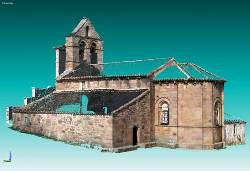May 25 2010
Researchers from the Cartif Foundation and the University of Valladolid have created full colour plans in 3D of places of cultural interest, using laser scanners and photographic cameras.
 Palencian church of Valberzoso
Palencian church of Valberzoso
The technique has been used to virtually recreate five churches in the Merindad de Aguilar de Campoo, a region between Cantabria, Palencia and Burgos which boasts the highest number of Romanesque monuments in the world.
"With this methodology an exact model of the monuments or places of interest can be obtained in a virtual way", Pedro Martín-Lerones, co-author of the study and researcher at the Cartif Foundation in the Technological Park of Boecillo (Valladolid), explains to SINC.
The project, which has been published in the Journal of Cultural Heritage, makes it possible to create three-dimensional plans with colour images of historical and artistic places of interest. The data is recorded by laser scanners that take the maximum number of geometric measurements from a minimum number of positions.
"This ensures that accuracy is maintained, whilst also reducing the time spent on field work, because generally more shots are usually taken than are needed", comments the researcher, who also explains that a three-dimensional model of the monument is produced "with millimetric accuracy, in comparison to the centimetric nature of conventional 2D templates".
The data provided by the laser scanner is complimented by images captured by photographic cameras. This information is processed using two specific software programs developed by the researchers themselves: one which superimposes the information in colour of the photographs onto the three-dimensional model, and another that generates the final plans in 3D in a timeframe that is 40% quicker than the traditional method.
Martín-Lerones highlights the many ways this study can be applied: "It makes it easier to draw up intervention projects, as well as preservation and renovation projects on churches or other buildings, in addition to its potential uses for popularizing -on the internet, for example- the monuments in 3D".
Information that is thousands of times better
The team has tested the methodology in five churches in the old Merindad de Aguilar de Campoo, located between the provinces of Palencia, Burgos and Cantabria. Of all those digitalized, the Palencian church of Valberzoso turned out to be one of the most representative, thanks to its artistic value, state of preservation and accessibility.
"There, it can be observed that by using three-dimensional measurement of a place of cultural interest the result is that the quantity of information captured is thousands of times better than what is obtained from conventional methods, whilst the time spent on field work is reduced by around 75%", Martín-Lerones points out.
In the Merindad de Aguilar de Campoo the highest number of Romanesque artistic monuments in the world can be found. Since 2005, it has been declared a Heritage Site by UNESCO and it is presenting an application for European Heritage again this year